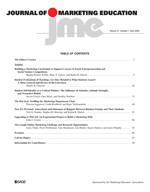Why Embrace Quantitative Methods?
Editor’s note: We’re pleased to welcome Crina O. Tarasi, J. Holton Wilson, Cheenu Puri, and Richard L. Divine, all of Central Michigan University, who published “Affinity for Quantitative Tools: Undergraduate Marketing Students Moving Beyond Quantitative Anxiety” in the Journal of Marketing Education.
While teaching a variety of marketing courses, from the introductory course to advanced courses at both the undergraduate and graduate levels, we have observed interesting (and disturbing) attitudes about quantitative analysis among marketing students. In brief, they just seem not to like working with the quantitative aspects of marketing. It may be that marketing students select this major because they see marketing as a qualitative area of study and work. However, in an increasingly data driven world it is important for marketing professionals to appreciate and be able to work with a variety of quantitative forms of analysis to gain information from the wealth of data that are available.
 In a way the results of our research have been confirmatory. Survey results do tell us that marketing students have less affinity for quantitative methods than do non-marketing majors and that women students have less affinity than do males. On a positive note we find that we can affect quantitative affinity in our classes as evidenced by the result that those students who have taken a marketing research class have stronger quantitative affinity than students who have not taken marketing research. As a result of our findings we may be able to better understand marketing students’ lack of quantitative affinity thus enabling us to better help them appreciate the role of quantitative analyses in their course work and careers.
In a way the results of our research have been confirmatory. Survey results do tell us that marketing students have less affinity for quantitative methods than do non-marketing majors and that women students have less affinity than do males. On a positive note we find that we can affect quantitative affinity in our classes as evidenced by the result that those students who have taken a marketing research class have stronger quantitative affinity than students who have not taken marketing research. As a result of our findings we may be able to better understand marketing students’ lack of quantitative affinity thus enabling us to better help them appreciate the role of quantitative analyses in their course work and careers.
 Probably the most surprising finding was the insignificant relationship between internship experience and quantitative affinity. We thought students who had some professional experience in the workplace would develop a greater appreciation for the value and importance of quantitative methods. Not only was this relationship insignificant, but the observed sample means were opposite of the direction hypothesized. Maybe due to the less technical assignments they receive as interns, most students are not exposed to quantitatively based decision making. We were saddened to find confirmation in the data that marketing majors enjoy less the quantitative aspects of their job than their peers in other majors and that the female students are less confident than their male peers.
Probably the most surprising finding was the insignificant relationship between internship experience and quantitative affinity. We thought students who had some professional experience in the workplace would develop a greater appreciation for the value and importance of quantitative methods. Not only was this relationship insignificant, but the observed sample means were opposite of the direction hypothesized. Maybe due to the less technical assignments they receive as interns, most students are not exposed to quantitatively based decision making. We were saddened to find confirmation in the data that marketing majors enjoy less the quantitative aspects of their job than their peers in other majors and that the female students are less confident than their male peers.
The research we have published leads to several further research streams. First it would be interesting to know how a student’s quantitative attitude affects the decision about what major is selected. Second, we would like to understand what/who influence the formation of marketing students’ attitudes about quantitative methods. Is it prior educational experiences in college? Is it pre-college educational experiences? Is it parents? Is it fellow students? Third, it would be interesting to know how the attitudes change once a student has, perhaps five years, work experience. Along this line we would like to investigate whether the career path within marketing makes a difference. Fourth, it could be useful to use the instrument that we developed to evaluate how what we do in courses influences students’ quantitative attitudes. The instrument could be administered both at the start and end of particular courses: perhaps the intro course, the marketing research course, and the capstone course. It may also be possible to use the instrument to evaluate various interventions that we develop in an attempt to improve quantitative affinity.




























































































